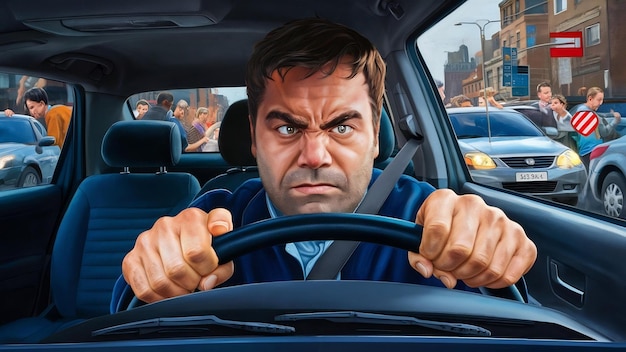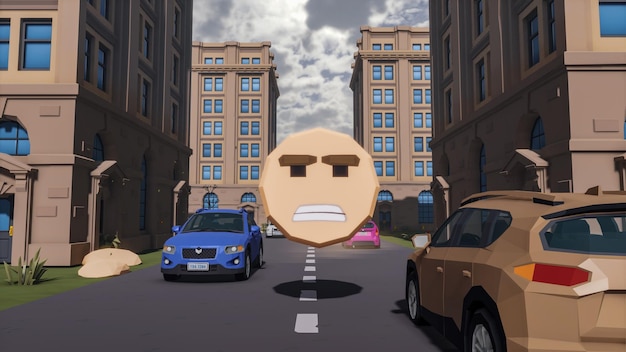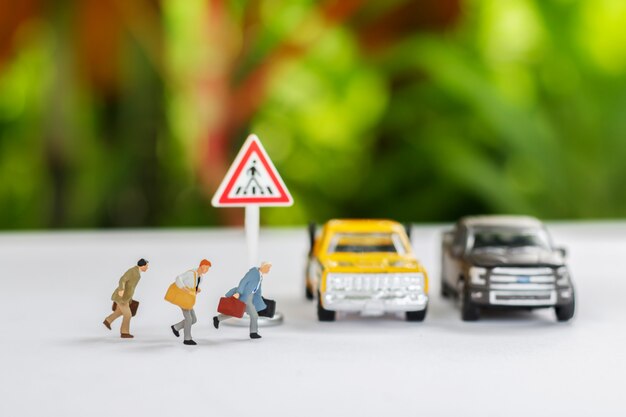Caught on Camera: The Shocking Consequences of Road Rage
Quick Read
Caught on Camera: The Shocking Consequences of Road Rage
Road rage, a dangerous and irrational reaction to driving annoyances, has become an increasingly common issue on our roads. It is a serious matter, with consequences that can range from minor damage to life-threatening situations.
Reckless Actions
In a split second, the temper can flare up, leading to reckless actions that put not only the driver but also other road users at risk. These actions could include tailgating, honking excessively, cutting off other vehicles, and even physical violence.
An Epidemic
Unfortunately, road rage is an epidemic, with numerous cases reported daily, especially in densely populated areas and during rush hour.
Consequences
The consequences of road rage are far-reaching and devastating. Besides the potential for physical harm, it can also result in legal repercussions and hefty fines. Moreover, it damages the reputation of the involved parties, leading to emotional distress.
Avoiding Road Rage
It is essential to remain calm and composed while driving. Here are some tips for avoiding road rage:
Avoid distractions
Stay focused on the road and avoid distractions such as using your phone or eating while driving.
Give way gracefully
Always give way to others, even if you believe they are in the wrong. It helps maintain a peaceful driving environment.
Keep a safe distance
Maintain a safe following distance from the vehicle in front of you to avoid tailgating.
Use turn signals and horn correctly
Use your turn signal to indicate your intentions, and only use the horn when necessary.
Conclusion
Road rage is a serious issue that can have far-reaching consequences. It is crucial to remain calm and composed while driving to ensure the safety of yourself and others on the road. Remember, a little patience and understanding can go a long way.
By following these simple tips, we can all do our part to reduce road rage incidents and make the roads a safer place for everyone.

I. Introduction
Definition and explanation of road rage
Road rage refers to aggressive or angry behavior by a driver towards another driver or pedestrian, while on the road. This behavior can manifest in various ways, including verbal abuse, physical violence, or emotional outbursts. It is important to note that road rage extends beyond simple honking or shouting and can have serious consequences.
Importance of understanding road rage and its consequences
With the increasing number of cases due to heavy traffic and stress, it is crucial to understand the concept of road rage. Potentially, this aggressive behavior can result in serious injury or even death for those involved.
Explanation of the structure of the presentation
In this presentation, we will delve deeper into the background of road rage. We will then explore its causes and symptoms in detail. The main focus of our discussion will be on the consequences of road rage, which can be legal, psychological, social, and personal. Lastly, we will discuss prevention and intervention strategies to minimize the occurrence of this dangerous phenomenon on our roads.

Background of Road Rage
History of road rage
Road rage, a form of aggressive and violent behavior by drivers towards other road users,
growing use of technology
in vehicles. With the advent of advanced navigation systems, hands-free devices, and other gadgets, drivers became more isolated from their surroundings, leading to a heightened sense of entitlement and decreased tolerance for others on the road.
Statistics on road rage incidents
Number of cases: According to various studies, the number of reported road rage incidents
has been on the rise
in recent years. In the United States alone, approximately 1,000 cases are reported each day. However, it is believed that many incidents go unreported, making it difficult to establish an accurate count.
Demographics:
The demographic profile of road rage offenders varies, but some common trends have emerged. Younger drivers, particularly men between the ages of 18 and 34, are disproportionately represented in road rage incidents. Additionally,
economic stress
and mental health issues, such as anxiety and depression, are believed to be contributing factors in some cases.
Locations and causes: Road rage incidents can occur anywhere, but they are most common in urban areas with heavy traffic congestion.
Common triggers
include tailgating, lane changing without signaling, failure to yield the right of way, and honking horns. In some cases, road rage incidents escalate into physical altercations or even deadly violence.

I Causes and Symptoms of Road Rage
Common triggers for road rage:
- Traffic congestion: Long delays, backed-up traffic, and slow moving vehicles can cause significant frustration and stress.
- Aggressive or reckless driving by others: Tailgating, lane changing without signaling, and speeding are common causes of road rage.
- Tailgating, horn honking, and other forms of verbal or nonverbal aggression: These behaviors can be perceived as deliberate attempts to provoke anger and aggression in other drivers.
Physical and emotional symptoms of road rage:
Road rage can result in a range of physical and emotional symptoms:
- Increased heart rate and blood pressure: Road rage can cause a significant increase in both heart rate and blood pressure, which can be dangerous if left unchecked.
- Anger, frustration, and anxiety: These emotions are common reactions to the triggers of road rage, and can escalate quickly if left unchecked.
- Aggressive thoughts and behaviors: Road rage can lead to aggressive thinking, such as road rage fantasies, and even dangerous or violent behavior.
Progression of road rage to violent behavior:
Road rage can escalate quickly, leading to potentially dangerous or even deadly situations. Some possible steps in the progression of road rage include:
- Escalating aggression: Road rage can start with verbal or nonverbal aggression, but can quickly escalate to more dangerous behaviors such as tailgating, cutting off other drivers, or flashing headlights.
- Loss of control and impulsivity: As the emotional response to road rage intensifies, drivers may lose control of their emotions and behave impulsively.
- Potential for serious injury or death: The consequences of road rage can be severe. Physical fights, car accidents, and even homicides have been linked to road rage incidents.

Consequences of Road Rage
Legal Consequences
- Criminal charges and penalties: Road rage incidents can lead to various criminal charges such as assault, battery, or reckless endangerment. The consequences of these charges can range from fines and community service to imprisonment.
- DUI or DWI charges: If road rage leads to driving under the influence or while intoxicated, the consequences can be severe, including suspension of driving privileges, fines, community service, and even imprisonment.
- Lawsuits for damages and injuries: Victims of road rage incidents can file lawsuits to seek compensation for damages and injuries sustained during the incident.
- Possible financial consequences: The financial implications of a road rage incident can be significant, including medical bills, legal fees, and lost wages.
- Depression: Some individuals may experience depression as a long-term consequence of road rage, particularly if they are involved in multiple incidents or have a history of anxiety or mood disorders.
- PTSD: In extreme cases, road rage incidents can lead to post-traumatic stress disorder (PTSD), which can significantly impact a person’s ability to function in daily life.
- Anxiety disorders: Road rage can also contribute to the development of anxiety disorders, such as panic disorder or generalized anxiety disorder.
- Family: Road rage incidents can strain relationships with family members, particularly if they are involved in the incident or bear the brunt of the emotional fallout.
- Friends and colleagues: Road rage can also damage relationships with friends and colleagues, who may avoid the individual due to their volatile behavior.
Civil Liability
Psychological Consequences
Short-term effects: Road rage can lead to short-term psychological consequences such as anger, anxiety, and stress, which can negatively impact a person’s overall well-being.
Long-term effects:
Social and Personal Consequences
Damage to reputation and career: A road rage incident can damage a person’s reputation, particularly if it is widely publicized. It can also negatively impact their career, especially if they hold a position of trust or authority.
Strained relationships with others:
Negative impact on mental and emotional well-being:
Finally, road rage can have a negative impact on an individual’s mental and emotional well-being, leading to feelings of guilt, shame, and self-destructive behavior.

Prevention and Intervention Strategies
Personal strategies for managing road rage
- Mindfulness and relaxation techniques: Practicing mindfulness meditation, deep breathing exercises, or progressive muscle relaxation can help reduce stress levels while driving. These techniques can help you stay calm and focused during potentially volatile situations.
- Active listening and empathy towards others: Try to understand why the other driver might be acting aggressively, rather than reacting with anger. Remember that everyone has bad days and that aggressive driving is often a result of stress or frustration. Use active listening skills to communicate effectively if necessary.
- Avoiding triggers and practicing forgiveness: Identify your personal road rage triggers (e.g., tailgating, honking, etc.) and develop strategies to avoid them. Practice forgiveness towards other drivers and try not to hold grudges. Remember that your reaction to a situation is within your control.
Societal strategies for addressing road rage
- Education and awareness campaigns: Raising public awareness about the dangers of road rage through media campaigns, community events, and educational programs can help reduce aggressive driving behavior.
- Infrastructure improvements (better roads, traffic management): Investing in better road infrastructure and effective traffic management can help reduce congestion and the stresses that contribute to road rage.
- Law enforcement efforts to deter aggressive driving: Increased law enforcement presence and stronger penalties for aggressive driving can act as a deterrent to those who might otherwise engage in road rage behavior.
Role of technology in preventing road rage incidents
- In-car cameras and dashcams: Installing in-car cameras or dashcams can help document incidents of aggressive driving, making it easier to report such behavior to law enforcement and hold offenders accountable.
- GPS tracking and real-time traffic information: GPS technology can help drivers avoid congested areas, reducing the likelihood of encountering stressful driving situations. Real-time traffic information can also help drivers plan their routes more effectively and arrive at their destinations in a less agitated state.
- Mobile apps and other technological solutions: Mobile apps that offer features such as real-time traffic updates, parking availability information, and emergency response services can help reduce stress and improve safety while driving.

VI. Conclusion
In the context of modern-day traffic and transportation, road rage has emerged as a significant public health concern. This
VI. Conclusion
section aims to summarize the key points discussed in this article and emphasize the importance of understanding the consequences of road rage.
Summary of key points:
- Road rage is a form of aggressive and violent behavior exhibited by drivers in response to perceived provocations while on the road.
- It can lead to a range of negative consequences, including physical injuries, property damage, emotional distress, and even fatalities.
- The causes of road rage are complex and multifaceted, including individual factors like anger management issues, stress, and perceived injustices, as well as societal factors like traffic congestion, long commute times, and the normalization of aggressive driving behaviors.
Importance of understanding the consequences of road rage:
Prevention and intervention strategies are essential: Given the potential for serious harm, it’s crucial that individuals take steps to manage their anger and aggression while driving and that society as a whole works to create safer roads and reduce aggressive behavior.
a. Personal responsibility: Each driver has a personal responsibility to manage their emotions and respond to provocations in a calm, respectful manner. This can include practicing stress reduction techniques like deep breathing exercises or listening to calming music, avoiding distractions while driving, and adhering to safe driving practices.
b. Collective effort: At the societal level, prevention and intervention strategies can include education campaigns, traffic calming measures like roundabouts or speed bumps, and enforcement of traffic laws. Additionally, normative change efforts can help reduce the stigma surrounding aggressive driving and encourage more courteous behavior on the roads.
Call to action for individuals and society as a whole:
Personal responsibility: Each driver can take steps to manage their anger and aggression while driving, such as practicing stress reduction techniques, avoiding distractions, and adhering to safe driving practices.
Collective effort: Society as a whole can work to create safer roads and reduce aggressive behavior through education campaigns, traffic calming measures, and enforcement of traffic laws. Additionally, normative change efforts can help reduce the stigma surrounding aggressive driving and encourage more courteous behavior on the roads.
video

